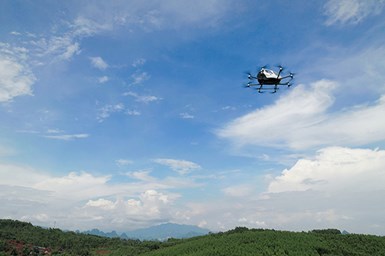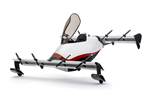EHang progresses operations, commercial deployment of EH216-S
Since the granting of its type certification, EHang is working toward production and airworthiness certification, along with prioritizing safe operations and accountability leading up to the eVTOL’s release.

Photo credit: EHang
EHang Holdings Ltd. (Guangzhou, China) announces that the company is progressing toward obtaining the production certificate (PC) and airworthiness certificate (AC) for its unmanned electric vertical takeoff and landing (eVTOL) EH216-S, with the full support of the Civil Aviation Administration of China (CAAC).
Notably, for these certifications, documentation review and most of the definition and practical assessments are completed, with inspection and test at EHang’s facility underway. The initial batch of the EH216-S is scheduled to roll off the production line with customer deliveries in Q4 2023.
EHang was formally granted type certification (TC) mid-October, grounded on principles of scientific integrity, exhaustive evaluation, and paramount safety and progressed within the structured framework of Chinese Civil Aviation Regulations Part 21 (CCAR-21).
The EH216-S has completed numerous test flights at high-altitude areas, proving its full capability in such scenarios.
The Type Certificate Data Sheet, released alongside the TC, is an integral document that accompanies the TCs for all aviation product categories. Operating under the “progressive risk” principle, the company prioritizes safe operations and accountability to the public to avoid unforeseen safety challenges in various situations once official commercial operations commence. EHang, adhering to the conventional principles of imposing prudent restrictions first and lifting restriction by stages akin to procedures observed in the introduction of new aircraft (such as limitations on defining flight routes, scheduling, operational assurances for commercial operations of airliners, etc.), has agreed with the CAAC in regards to operational limitations for the initial phase. EHang will gradually lift these operational limitations with the ultimate goal to realize comprehensive unmanned commercial operations across urban areas.
To ensure safety, EHang will closely monitor new routes during the first phase of commercial operations. Moreover, it will position extra observers in areas that are beyond the operators’ visual line of sight (BVLOS) to satisfy requirements for beyond visual line-of-sight operations. EHang plans to accumulate more experience while ensuring safety in the first stage.
Like conventional aircraft that take off and land on solid ground, the EH216-S passenger-carrying unmanned aerial vehicle (UAV) will not operate over water. However, according to specific needs of operational spots and route-setting requirements, there won’t be restrictions on water bodies like lakes, rivers, seaside and others when conducting aerial tourism and sightseeing experiences, as well as other low-altitude flights in certain urban areas. Under CAAC’s guidance of “conducted trial operations while advancing certification,” the EH216-S has completed numerous test flights at high-altitude areas, proving its full capability in such scenarios. Following the first phase of safe operations, EHang will further expand various operational scenarios and progressively introduce BVLOS flights and those at higher altitudes areas.
“Safety is the lifeline of the aviation industry,” Huazhi Hu, founder, chairman and CEO of EHang says. “Looking ahead, we will further advance UAV passenger-carrying flight operations and full-scale commercial deployments to achieve milestones in the development of the global low-altitude economy.”
Related Content
-
Composite sidewall cover expands options for fire-safe rail components
R&D project by CG Rail explores use of carbon fiber-reinforced thermoplastics and recycled manufacturing scrap to meet fire safety, weight and volume targets.
-
Lilium launches M&A process, targets eVTOL program continuation
Despite court-approved insolvency filings and beginning first investor briefings, Lilium remains fully focused on re-emerging following restructuring, setting its sights on fresh investment to support the Lilium Jet.
-
Honda begins production of 2025 CR-V e:FCEV with Type 4 hydrogen tanks in U.S.
Model includes new technologies produced at Performance Manufacturing Center (PMC) in Marysville, Ohio, which is part of Honda hydrogen business strategy that includes Class 8 trucks.
















